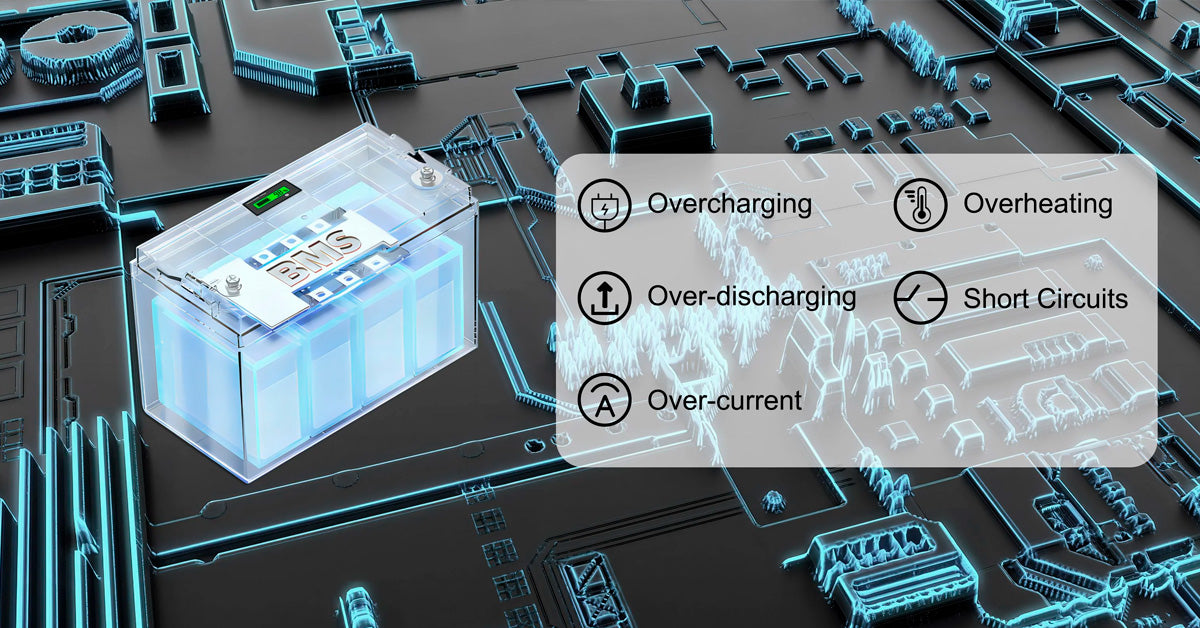Explore the critical role of built-in Battery Management Systems (BMS) in enhancing battery safety, efficiency, and longevity. Learn how BMS technology optimizes charging processes, prevents overcharging, and monitors battery health to ensure reliable application performance.
Battery management systems (BMS) represent the linchpin in modern rechargeable batteries' efficient functioning and safety, emphasizing lithium-ion technology. These sophisticated systems enhance battery performance and longevity and ensure operations are conducted safely through comprehensive management and real-time monitoring. In this expansive blog, we will delve into the intricate mechanics of BMS, highlighting its significance and efficiency across various applications, notably in electric vehicles, where it plays a critical role.
A Battery Management System (BMS) is essential to operating lithium-ion batteries, which are pivotal in everything from mobile devices to electric vehicles. The BMS is crucial for extending the life of these batteries and ensuring they are handled safely by implementing various protective measures. The primary role of a BMS revolves around diligently monitoring and managing the operational conditions of batteries, thereby preventing dangerous conditions like thermal runaway and mitigating risks associated with short circuits and overcharging.
Understanding Battery Management Systems (BMS)
What is a Battery Management System?
At its core, a Battery Management System (BMS) is a sophisticated ensemble of components tasked with effectively overseeing a rechargeable battery's charging and discharging cycles. The fundamental aim of a BMS is to protect the battery, extend its service life, and ensure it delivers optimal performance. It achieves this by continuously monitoring vital parameters, such as individual cell voltages and the overall state of charge (SOC). By keeping the battery within predefined safe operational limits, a BMS significantly boosts the battery's reliability and safety.
Components of a BMS
The structural design of a BMS incorporates a variety of sensors that track the conditions of each cell within the battery. These sensors feed data to a central processing unit (CPU) that interprets the information to maintain the health and efficiency of the battery pack. One of the pivotal roles of the BMS is to regulate the charge balance across all cells. This balance is critical to ensuring uniform performance of each cell, which is essential for maintaining the longevity and overall efficiency of the battery. This continuous balancing process, managed by the BMS, is crucial for the battery system's prolonged viability and enhanced functionality.

The Functions of a Battery Management System (BMS) in Lithium-Ion Batteries
Protection Features
The primary role of a Battery Management System (BMS) is to ensure the safety and integrity of lithium-ion batteries, especially in preventing and managing thermal runaway. Thermal runaway is dangerous in when a battery overheats and may even catch fire. Here’s how a BMS provides essential protection:
- Prevention of Thermal Runaway: By continuously monitoring the battery's temperature, the BMS can detect and respond to abnormal heat levels that might lead to thermal runaway.
- Circuit Protection: The system guards against short circuits, a common hazard that can cause significant damage to the battery and surrounding devices.
- Control Overcharging and Overdischarging: A BMS ensures that the battery does not exceed its upper and lower voltage thresholds during charging and discharging, which helps prevent overcharging or excessive depletion damage.
- Overall Safety Assurance: A BMS maintains the operational integrity and safety of the battery system through these protection protocols, thereby mitigating risks associated with its use.
Performance Optimization
A BMS protects lithium-ion batteries and plays a critical role in enhancing their performance and extending their lifespan. Key aspects of this role include:
- Sophisticated Monitoring: The BMS continuously monitors various parameters, such as voltage, current, and temperature, to ensure optimal battery operation.
- Management of Charging and Discharging Processes: By controlling these processes, the BMS ensures that the battery operates within its ideal range, which is vital for maintaining its health and efficiency.
- Longevity and Efficacy Maintenance: Through effective management and optimization, the BMS helps the battery maintain high performance, even under strenuous conditions, thereby extending its usable life.
- Performance Under Rigorous Conditions: The advanced strategies the BMS employs allow the battery to perform reliably and efficiently, even under extensive and demanding usage scenarios.
Advanced Monitoring Capabilities
Continuous Monitoring
The Battery Management System (BMS) excels in its capacity for continuous monitoring, closely observing the state of health (SOH) and state of charge (SOC) of each cell within the battery pack. This constant vigilance is crucial in maintaining overall battery health and operational integrity. By employing sophisticated algorithms, the BMS tracks real-time data and interprets these metrics to forecast possible battery malfunctions. This predictive capability is instrumental in preempting failures that could escalate into major operational issues, thereby enhancing both the safety and reliability of the entire battery system.
Further, the BMS's proactive monitoring approach is pivotal in extending the battery's lifecycle and reducing the likelihood of unexpected downtimes. It continuously evaluates the performance and efficiency of each cell, adjusting charging rates and discharging cycles as needed. This dynamic adjustment helps prevent conditions that could lead to battery degradation, such as overcharging or deep discharging, thus safeguarding the battery against potential hazards and ensuring a longer, more reliable service life.
Diagnostics and Reporting
A well-implemented Battery Management System does more than simply monitor; it integrates comprehensive diagnostic capabilities that generate detailed reports on the battery’s condition. These reports are essential tools for assessing the battery's overall health and predicting its lifespan. By analyzing data collected from regular monitoring, the BMS can identify patterns and anomalies that indicate the potential for future issues, allowing for timely interventions that can prevent performance degradation and extend the battery's operational life.
Moreover, these diagnostic reports provide valuable insights critical for maintenance planning and decision-making processes. They enable technicians and engineers to understand the complex interactions within the battery system and make informed decisions regarding maintenance schedules, replacement timing, and warranty management. Through accurate and timely diagnostics, the BMS ensures that the battery operates at peak efficiency, optimizing its functionality and longevity in various applications.
Applications of BMS in Electric Vehicles
BMS in EVs
In electric vehicles (EVs), the Battery Management System (BMS) is an essential component, ensuring both safety and efficiency in battery operation. The significance of the BMS extends to scenarios involving high-demand applications, where the stakes for battery performance and safety are elevated. Through meticulous monitoring and management, the BMS enhances how the battery pack is utilized, optimizing its performance to achieve maximum efficiency. This optimization plays a pivotal role in extending the vehicle's operational range, directly influencing its overall efficiency on the road.

Impact on Electric Vehicle Performance
Effective battery management extends beyond safety; it is a crucial factor in boosting the performance and driving range of electric vehicles. Advanced BMS technologies have been central to numerous case studies, each demonstrating substantial enhancements in the operational capabilities of EVs. These improvements are critical for pushing the limits of what electric vehicles can achieve, underscoring the BMS's vital position within the automotive industry.
Key points from these case studies include:
- Enhanced Safety Measures: Advanced BMS ensures all safety protocols are met, reducing the risk of battery-related incidents.
- Increased Vehicle Range: BMS technology optimizes battery usage, helping to maximize the distance an EV can travel on a single charge.
- Improved Battery Efficiency: Sophisticated BMS algorithms enhance the overall efficiency of the battery pack, leading to better vehicle performance.
- Industry Adaptation: The evolving nature of BMS technology demonstrates its growing adoption and refinement within the automotive sector.
Enhancing Longevity and Safety
Longevity of Batteries
Advanced Battery Management Systems (BMS) technologies significantly enhance the longevity of batteries by precisely controlling their charging cycles and usage patterns. This meticulous management helps maximize efficiency and lifespan, which are essential for maintaining the battery's health over prolonged periods. By optimizing charge states and preventing overcharging, LANPWR batteries with BMS can extend their useful life, ensuring they perform well for their intended operational life.
Moreover, intelligent algorithms embedded in modern BMS actively analyze the battery's real-time data to adapt its operations to various environmental conditions and usage demands. This adaptive approach not only aids in preserving the battery's condition but also optimizes its performance across different scenarios. As a result, batteries equipped with advanced BMS are less prone to efficiency losses and potential degradation, thereby sustaining their capacity and power for longer durations.
Ensuring Safety
The sophisticated monitoring capabilities of a Battery Management System (BMS) are paramount in preventing accidents and enhancing the safety of battery-operated devices and vehicles. Through continuous monitoring and active management, BMS technologies can detect any irregularities in battery behavior, such as unusual temperature spikes or voltage fluctuations, which are often precursors to battery failures. This proactive approach significantly mitigates risks associated with battery operations, ensuring a safer environment for both the device and its users.
Furthermore, by implementing strict protocols and safety measures, BMS ensures that all operational parameters of the battery stay within safe limits. This includes real-time adjustments to the charging current and voltage, as well as emergency responses like disconnecting the battery if a critical issue is detected. Such comprehensive management not only prevents hazardous situations but also reinforces the reliability of the system, contributing to the overall safety and trust in battery-powered solutions.
Integrating advanced Battery Management Systems (BMS) technologies is crucial for the continual development and enhanced safety of battery-operated systems. As we delve further into the age of digital and portable technologies, the importance of effective BMS cannot be overstated. These systems are pivotal in managing the operational health of batteries, ensuring they perform optimally while avoiding issues such as overcharging, deep discharging, and thermal imbalances, which can lead to catastrophic failures.
Furthermore, as the demand for more efficient, reliable, and safer battery technologies grows, the role of BMS in safeguarding these energy sources is becoming increasingly vital. The future of battery management looks promising, with potential advancements that could lead to even smarter, more adaptive systems. These advancements are expected to enhance the performance and lifespan of batteries and play a significant role in promoting sustainability by optimizing battery usage and reducing waste. As technology evolves, the strategic integration of sophisticated BMS technologies will remain at the forefront of ensuring the safety and efficiency of battery-operated systems worldwide.
Consider the significant benefits of incorporating a sophisticated BMS in your battery-operated devices or vehicles. For more insights and detailed studies on BMS technologies, follow the links to further reading and resources below.












Leave a comment
This site is protected by hCaptcha and the hCaptcha Privacy Policy and Terms of Service apply.